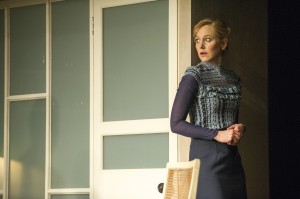Playing Doll: A Doll’s House at The Young Vic
Luckily for those in London between 28 March and 20 April the Young Vic’s critically acclaimed production of Ibsen’s A Doll’s House is staging a three-week revival. If you’re in London you have to be lucky or at least quick-witted to get a ticket for this hotly anticipated show; its short run is a sell-out. Most major British newspapers have lauded the production, so with overwhelmingly positive reception, there has been great anticipation for its return.
Posters for this production line the insides of London tube stations: an image of Morahan as Nora intently gazes at you. Those who strolled from the Young Vic to the nearby Tate Modern may have been reminded of a Meredith Frampton painting upon seeing Nora. Portrait of a Young Woman is her stilled life equivalent. A perfect porcelain doll; there is something beyond that glance.
The Young Vic is a London theatre with a great ethos. Its focus? Involving younger generations and not pricing audience members out of a seat. Its informal and welcoming atmosphere, plays out as soon as the audience steps into the building. It is also forward thinking. A short film entitled Nora featuring Hattie Morahan as a modern-day version of her character can be found on the Young Vic website. The fact that this theatre is exploring modern mediums alongside its stage performances proves it is a company thinking beyond the realms of its auditorium.
Ian MacNeil’s design was spectacular. The rotating stage gave the play a cinematic feel. The construction itself seemed to be like a gigantic toy house, spun by the invisible hands of a child. Images of domestic life caught up in the rotation transformed the stage into a zoetrope.
The rise and fall of ominous music and sinister shaking of Christmas bells signalled not only the festive period but also Nora’s metamorphoses. The flash of lights made the stage itself seem possessed, or as if an earthquake was about to erupt. Audience members familiar with the plotline were aware something momentous was about to take place.

Hattie Morahan in A Doll’s House at the Young Vic, photo by Richard Hubert Smith.
To be given the part of Nora is asking a lot of anyone. Hattie Morahan won both the London Evening Standard and Critics Circle awards for Best Actress. Morahan’s ability to change from harmless plaything to assertive woman instantaneously, simply through changing her tone, was astounding. The portrayal of Ibsen’s creation confirmed her accolades.
Every production of A Doll’s House must be memorable. It must stand out as an original in the face of a behemoth such as Ibsen’s script; a script which threatens to cast any production in its shadow due to its historical importance. The thing this Young Vic production does so well is to make Ibsen its own, making sure Nora’s departure is still as shocking as ever.
The reception of Ibsen’s play represents a timeline of progression; it runs parallel to advances made in women’s rights and in personal freedom. The positive reaction of today’s audience is a reminder that 21st century Britain is a very different world to the one Ibsen experienced. Does that mean Ibsen’s play has become any less poignant? That it has lost any of its impact? This play is performed now more than ever, so this cannot be the case. It is so regularly enacted; Ibsen presents the eternal problem of personal freedom. People still experience what Nora experiences in the play. She is a role model to many for this reason. Her problems are the problems of society, and ongoing issues.
A Doll’s House may be shrouded in historical significance but its final scene has lost none of its impact. It has not become dated or stale. The closing of the door still reverberates round the Young Vic as it would have done a hundred years ago. It still continues to reverberate round the theatres of the world. You wait to hear it. You anticipate it, yet, in that moment in the play, you are speechless. When Nora leaves the stage and ventures out of sight the audience is unable to follow her. The future for Nora, and others, still remains uncertain. It is a tale of hope and of individual freedom, but also one of continuation, it is a play to be performed to the world, and is as relevant as ever.

Comments